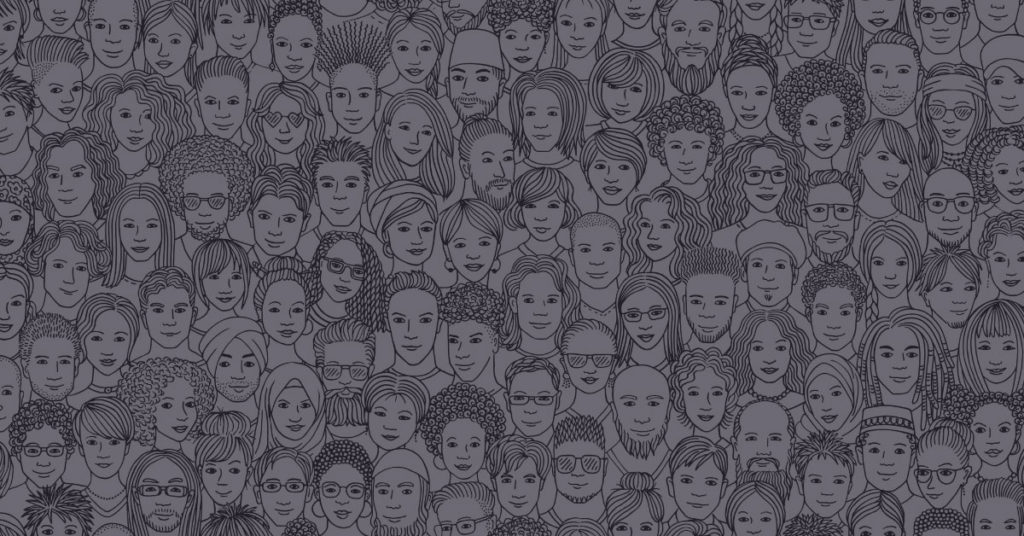By Niki Jagpal and Maddie Schumacher

This post, originally published on December 17, 2020, is relevant during Asian Pacific American Heritage Month (APAHM). Especially in the wake of the racist mass shooting in Buffalo, NY that took 10 lives and injured three more this past weekend, it remains important to call for the eradication of the anti-Blackness that permeates globally. The Asian American and Black communities have a history of solidarity to build on. Working together, we can build true racial solidarity and move all communities closer to equity.
COVID-19 has brought race and racism within and against the Asian American¹ community front and center in the public sphere. There have been an unprecedented number of anti-Asian American attacks documented since January, leading to public sector, nonprofit advocacy, and media attention. This spike in hate incidents and hate crimes, alongside protests against police violence across the country, has re-centered the persistent anti-Black racism in Asian American and Asian communities, as well as persistent racial tensions between Asian American and Black communities in the U.S. These tensions are magnified by the COVID-19 pandemic, which is disproportionately affecting and killing Black and Asian Americans, and other people of color.
Many have highlighted the need to build Afro-Asian solidarity in the United States — with taglines like AAPIs for Black Lives and Yellow Peril Supports Black Power. But these calls are empty without an understanding of racism on the international scale. Additionally, solidarity efforts are hollow as long as Asian Americans continue to buy into, and perpetuate, the model minority myth — and its underlying meritocratic colonialism². Looking at the systemic meeting points of Asian America and Black America in the U.S., as well as Black and Asian communities in Asia, Africa, and Europe, it becomes clear that issues of racial interaction and solidarity-building extend outside American boundaries. Ignoring how race and hierarchy function outside of our geographic boundaries leaves us with little context for seeing the complexities of anti-Blackness in a globalizing world. What does this suggest for the future of intersectional, multiracial, and transnational movement work? How can we use the current moment of rising tensions and movement-making to build an Asian anti-racist paradigm — one that addresses the root causes of these obstacles, foremost being anti-Blackness?
We suggest that the answers to these questions lie in looking at race in the context of a colonial and postcolonial³ economic paradigm.
One of the major differences between China and other Asian countries is the fact of colonialism. China was not colonized by the West in the same ways that other ‘Third World’ countries were. It was and continues to be its own empire that colonizes other east and southeast Asian countries. This has significantly impacted the evolution of China’s economic and racial ideals. Because the Chinese do not have a subaltern identity⁴, the power dynamics that inform their racial views are starkly different than the evolution of Black identity and voice.
The facts of slavery and colonization on global Black economic and racial realities are well documented.⁵,⁶,⁷,⁸. It has been more than a decade since China overtook the U.S. as Africa’s largest trading partner. Chinese infrastructure investments in ‘developing countries’ totaled nearly $614 billion between 2013–18. In Africa, some see China’s investment and extraction campaign as modern colonialism. China now holds 14% of the total debt stock in sub-Saharan Africa and is the largest owner of public debt in the continent. Nations involved in Chinese investments risk losing control of their essential infrastructure and natural resources and continue to increase their debts to the international superpower.
With this economic backdrop, China has now taken on the role of extractor in Africa, and this power differential serves as the basis for racialization and othering of Black people in China and broader Asia. Black immigrants in China experience racism and anti-immigrant sentiment similar to South African apartheid and American segregation. In an article documenting how the coronavirus has exposed China’s long-entrenched racism, Hsiao Hung Pai notes that — because they were seen as the source of the COVID-19 virus — Black immigrants have been subject to surveillance, banned from entering shops and healthcare facilities, and quarantined. Recently, a McDonald’s put up a notice banning Black people from entering. All this as anti-Asian discourse and violence have spiked in the U.S. in the wake of the pandemic, enabled by an administration that continues to refer to COVID-19 as the ‘China’ virus.
Despite the paradoxical social contexts of the U.S. and China, it is clear that the racial structuring of the “other” is parallel. For Asian Americans in the U.S. and Black people in China, both are seen as sources of contagion in a COVID-19 pandemic, both are expected to assimilate into the dominant race, and both are located within diasporas related directly to U.S. and Chinese hegemony. Even though different nations and hierarchies are acting upon different racialized communities, it is ultimately the same oppression and scapegoating of the “other.” And this exertion of power on vulnerable immigrants replicates precisely the power dynamics of colonialism.
The answer lies not in parsing “race relations” but instead in assessing the root causes of the oppression that we exert on each other. This requires looking at each context — being Black and Asian American in the U.S.; being Southeast Asian in China; or being Black in Europe — as both separate and part of a whole system of racial categorization and oppression driven in large part by global economic power (or capitalist colonialism). In doing so, we must remember that — even though all diasporic Asians and diasporic Blacks have been reductively racialized the same: as Asian and Black respectively, these categories are false. The Asian and Black diaspora populations are some of the most diverse in languages, cultures, ethnic identities, religions, traditions, and migration patterns. Our first step in challenging colonial oppression is deconstructing the reductive race categories that have allowed racial supremacy to exist in an increasingly globalized and interconnected world.
How do we develop a truly transformational and inclusive approach to race? With our fundamental racial categories determined by whiteness, white supremacy⁹, and colonial dynamics, we first must question our relationship to whiteness and to each other. Both Asian American and Black communities have been and continue to be excluded from full participation and representation in the U.S. In so, a shared subaltern identity has been forged: as a “person of color in the U.S.” This identity has to be the foundation for AAPIs doing multiracial coalition work (as opposed to our work being driven by pity or charity). The oppression that is exerted onto Asian Americans is the same oppression that simultaneously drives anti-Black racism. Asian Americans engaged in policy therefore can and have the responsibility to be inclusive within a larger intersectional framework of other communities of color. It is further our responsibility to abolish the ‘model minority myth’ which is and has always been predicated on the assignment of Black communities as ‘problem minorities.’
From housing to economic justice and workplace discrimination, we call on Asian American community-based organizations to address the deep-seated anti-Blackness in and outside our communities. We need a fundamental shift in our approach to race.
We suggest three goals that Asian American organizations and people must take to fulfill their responsibilities as pursuers of justice and members of a multiracial society.
Abolish the model minority/problem minority myth
It is up to us to recognize the diversity of the Asian American community and build an understanding of the ways in which war, capitalism, colonialism, and white supremacy shape Asian American identity. This requires us to build awareness of the levels of income inequality within the community; Asian Americans have the highest income inequality of any other racial group in the country. Economic indicators in our communities are skewed by highly concentrated income at the upper bound of the distribution; in short, we have hyper-concentrated wealth at the top that makes it appear that the entire community is doing well. In contrast, there is extended and concentrated poverty among certain communities: e.g., Bangladeshi community. Recognizing the economic and non-economic diversity of Asian American communities forces us to realize that capitalism and race are deeply intertwined. In the same way, the model minority/problem minority myth was originally formulated to rationalize the oppression of Black communities and other communities of color. The root of our solidarity building with each other must be founded in disrupting the economic system that keeps non-white communities marginalized.
Already, the changing demographics of Asian America jeopardize this myth of a model minority. The recent influx of Asian refugees and other brown, undocumented, queer, and working-class Asian immigrants fundamentally shifts the merit assigned to Asian America by whiteness. But not fast enough — we must do the work of calling out model minority/problem minority myth narratives at the family level and in the larger public narrative. We must understand that our humanity is tied deeply to repositioning ourselves alongside BIPOC, and not with the hope of assimilating into a white supremacist racial hierarchy.
Eradicate anti-Blackness in our communities
Founded on the model minority/problem minority myth that we have internalized, there is deep and impactful anti-Blackness at work in Asian American communities. Oftentimes, this anti-Blackness takes the form of colorism, where Asian and non-Asian individuals with dark skin and Black-perceived features are viewed as ugly, unintelligent, non-feminine, and problems. It is our responsibility to dispel anti-Blackness on the individual and systemic levels by speaking out and speaking with our communities. The model minority myth additionally codes Asian Americans as apolitical and silent, undermining multiracial collaboration. Fortunately, we can follow the lead of anti-racist Asian Americans and Pacific Islanders who have been doing this work for decades. By borrowing their tactics and sharing knowledge, we can have intentional conversations and build modern movements to engage Asian Americans on anti-Blackness, Black Lives Matter, and neo-colonialism.
Build coalitions and solidarity
As Asian American organizations work toward being in authentic relationship with Black-led organizations, we must ensure that our coalition work does not replicate colonial hegemony. To demonstrate a transformational approach to working in coalition, center Black-led organizing and relationship-building. Actively fight the capitalist expectation of extraction and competition in order to create mutually-beneficial and consensual partnerships where transaction is not the means nor the end. Enter the space with humility. Do the hard work of self-education about anti-Blackness in our communities and take steps to raise these issues and strategize around them. The possibilities for transformational and race-conscious coalition are tremendous. When we join together in coalition to fight, we win.
The authors thank Britt Yamamoto, Kabzuag Vaj and Charlie Piot for their thoughtful contributions and review of this piece.
Footnotes
¹ We acknowledge that the Pacific Islander community has seen disparate impact from COVID and experiences racism but made the intentional decision to focus our writing on the Asian American community as we cannot do justice to the complexities of race in the PI community in this piece.
² By ‘meritocratic colonialism’ we mean a belief that colonized communities are oppressed for their own good or because they deserve it.
³ The terms colonial, neo-colonial, imperialism, and racial formations under power differentials are very specific (e.g., in Africa, colonialism refers to the 1884–1960 time period in which states/colonies with specific racial dynamics were established in Africa versus the prior three centuries of European imperialism and the slave trade). While acknowledging this nuance, we choose the terms colonial and postcolonial intentionally because we contend that the exercise of power is the same today as under colonialism (see, e.g., neocolonialism and imperialism definitions)
⁴ A subaltern identity is an identity developed under oppression.
⁵ Coates, Ta Nehisi. “The Case for Reparations.” The Atlantic, June 2014.
⁶ Rodney, Walter Anthony, et al. How Europe Underdeveloped Africa. Verso, 2018.
⁷ Moyo, Dambisa. Dead Aid: Why aid is not working and how there is a better way for Africa. Farrar, Straus and Giroux, 2009.
⁸ Moyo, Dambisa, Winner Take All: China’s Race for Resources and what it means for the world. Basic Books, 2012.
⁹ We use Scot Nakagawa’s definition of white supremacy: “the parent ideology of contemporary racism and the historic foundation of American political-economy that is now experienced as structural racism, a historic construct.”



